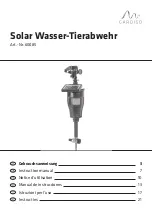
Consequently, the software can be used to calibrate the analog output without
the need for any hardware Trim-pot adjustment. For example,
Channel n
MinV[n]
MaxV[n]
MinI[n]
MaxI[n]
0 134 16297
8180
15943
1 137 16293
8172
15976
2 132 16296
8199
15949
3 134 16391
8177
15963
4 135 16298
8165
15955
5 131 16292
8150
15947
6 136 16295
8172
15968
7 134 16297
8163
15961
8 134 16294
8188
15959
9 132 16295
8169
15948
10 135 16298
8172
15946
11 133 16296
8177
15975
12 131 16292
8159
15942
13 134 16297
8173
15973
14 132 16293
8168
15949
15 133 16295
8175
15965
If the user wants to send Vout(volts) to Channel n, the calibrated hex value,
DaValue, sent to D/A converter can be calculated in the following way:
DeltaV[n]=20.0/(MaxV[n]–MinV[n]);
/* DeltaV[n]=volts per count at channel_n */
DaValue=(Vout+10.0)/DeltaV[n]+MinV[n];
/* DaValue=Hex value to send to the D/A */
pio_da16_da(n,DaValue);
/* send the DaValue to Channel n */
If the user wants to send Iout(mA) to Channel n, the calibrated hex value,
DaValue, sent to the D/A converter can be calculated in the following way:
(Refer to DEMO9.C)
DeltaI[n]=20.0/(MaxI[n]–MinI[n]);
/* DeltaI[n]=mA per count at channel_n */
DaValue=Iout/DeltaI[n]+MinI[n];
/* DaValue=Hex value send to D/A */
pio_da16_da(n,DaValue);
/* send the DaValue to Channel n */
Refer to DEMO7.C and DEMO9.C for more information.
PIO-DA/PISO-DA Series User Manual (Ver.2.9, Feb. 2011, PMH-009-29 )
22
















































